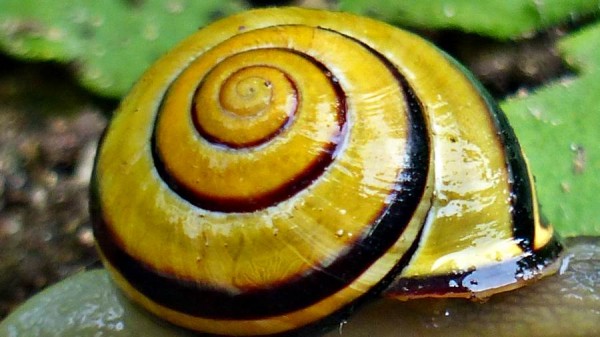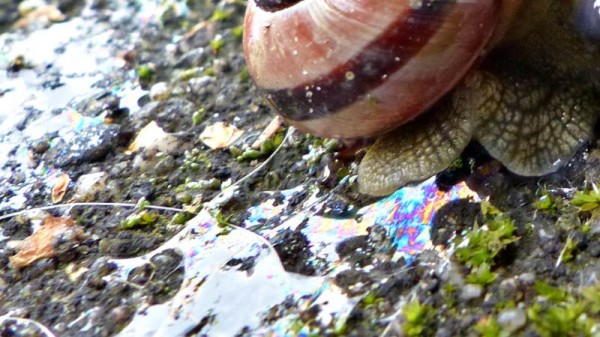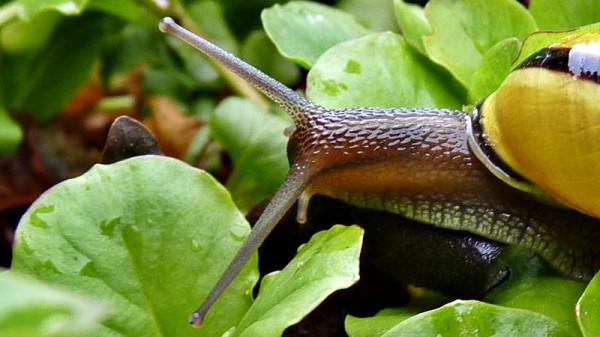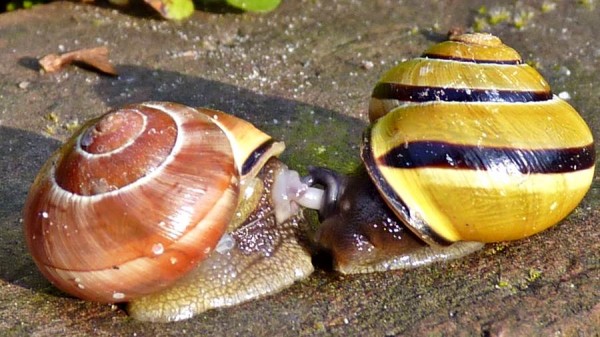The common garden snail, also called land snail, is a house snail and is the most common snail in the Netherlands and Belgium. The snail can move through the sole of the foot. This is a strong muscle on which the cochlea rests and which contracts and stretches again, revealing a mucus trail. The common garden snail is nocturnal but can also be active during the day in rainy weather. A rain shower therefore ensures that many snails can be seen. Rainy weather is also called snail weather in meteorology.
- The common garden snail (Cepaea nemoralis), a land snail
- Characteristics of the common garden snail
- The cochlea
- Silver spur
- Tongue grater or radula
- Eyes on stalks
- Love arrows provide offspring
- Enemies
The common garden snail (Cepaea nemoralis), a land snail
Snails or gastropods (Gastropoda) are a class of the tribe of Mollusca (mollusks). Most mollusks live in the water (water snails) and breathe through the gills. A small proportion of the molluscs breathe through the lungs, including the land snails. Other names for the common garden snail are dune snail or pink garden snail. The common (black-edged) garden snail (Cepaea nemoralis) is of the genus Cepaea, from the family of snails (Helicidae) and is a land snail. They have:
- a week body that consists of 80% water;
- no internal skeleton;
- an external shell.
Of all 150 species of land snails in the Netherlands and Belgium, the common garden snail is the best known.
Characteristics of the common garden snail
The common garden snail consists of a large muscle (sole of the foot) and by contracting and extending the muscle, the snail slowly crawls forward. The front part, next to the sole of the foot, is the head of the common garden snail and on top of the sole of the foot is the shell or snail shell. The snail shell is produced by the common garden snail and grows with it, which is why the snail is also called house snail. The cochlea consists of one piece and in the cochlea are the organs with heart, lungs and intestines. The cochlea gives the snail strength and protection. The common garden snail has a maximum of five black color bands on the cochlea and this is about 25 millimeters in size. An adult specimen has a dark thickened band (mouth lip) around the mouth opening of the cochlea. The mouth lip of the not yet adult snails is lighter in color (to white) and not yet thickened. The snail has two pairs of tentacles on its head. The top two tentacles have the eyes and the bottom two tentacles are for navigation, smelling and feeling. The common garden snail has both male and female sex organs.
Garden snails are a pest to garden plants, but nine times out of ten, snails mainly eat plant waste, such as dead leaves, dead insects, fungi and wood. The snails process this into compost and are therefore useful animals. The snails themselves are food for birds (the blacksmith of a song thrush), mice, hedgehogs, frogs and toads. In cold winters and dry times, the snail goes underground and hibernates to emerge around spring. The common garden snail is nocturnal, but in rainy weather they can also be seen during the day.
 The black / brown mouth lip of an adult common garden snail.
The black / brown mouth lip of an adult common garden snail.The white-edged garden snail
The common garden snail (Cepaea nemoralis) is very similar to the white-edged garden snail (Cepaea hortensis). The white-edged garden snail is slightly smaller than the regular garden snail. Both can be yellow, pink, or brown in color. The distinction between the white-edged garden snail and the common garden snail can only be seen in the fully grown cochlea of both species. The rim (mouth lip) of an adult cochlea snail is slightly bent and colored. The white-edged garden snail has a white / pale mouth lip and the common garden snail a brown / black mouth lip. Immature snail shells of both species have a brittle, colorless and not yet thickened edge.
The cochlea
The different colored snail shells of the common garden snail have a maximum of five dark color bands wrapped around the snail shell. The cochlea consists of lime and other minerals. It protects the snail from enemies and prevents it from drying out. After one to two years, the common garden snail develops a black / brown mouth lip on the cochlea, then the snail is mature. Once adult, the snails can live for a few more years.
 The silver trail
The silver trailSilver spur
At the mouth, on the underside of the head, is a gland with which the common garden snail can make slime, the so-called silver spore. The slime protects the sole of the snail’s foot and makes it easy to move, especially on a rough surface. Snails also leave a specific odor through the slime trail:
- to find shelters and feeding areas;
- before fertilization;
- before hibernation. The house snails then close off the opening of their shells.
Tongue grater or radula
The mouth of the garden snail has a raspy tongue (the radula). The radula has thousands of very small teeth in rows with which the snail grates the food into small shreds. Food such as nettles, plant remains, fungi, carrion, excrement, leaves of herbaceous plants, algae and fruit. The snail leaves a clear food trail as it eats.
 Eyes on stalks.
Eyes on stalks.Eyes on stalks
The common garden snail has two pairs of tentacles (feelers) on its head. The upper and longest tentacles are the eyes (literally the eyes on stalks) and the lower tentacles are for smelling, feeling and navigation. The eyes at the top of the tentacles probably see changes in light but not shapes. Snails make contact with each other with the upper tentacles (stalk contact). When in danger they retract their antennae and quickly disappear into their house.
Love arrows provide offspring
The common garden snail is ambiguous (hermaphrodite). This means that every snail has both male and female sex organs. To reproduce, they must fertilize each other. The snails find each other by using the silver trail. The genitalia of the garden snails are on the right side of the foot, under the cochlea and behind the head. During mating, the two snails are literally attached to each other head to head and fertilize each other by means of the love dart. The love arrow is a harpoon-like lime arrow and is in an arrow bag where a hormone-like substance is produced. The love arrow is part of the courtship ritual and stimulates ejaculation. When mating then takes place it can take hours. Both snails develop eggs that look like white beads. First these are in the body to be buried in the ground after two weeks. From the end of May to August, the 20 to 30 eggs are buried to emerge after a few weeks as young snails with a translucent snail shell. The adult common garden snail can deposit eggs up to four times and can live to be about 7 years old.
 Mating common garden snails.
Mating common garden snails.Enemies
The sun is the biggest enemy and the common garden snail is therefore a nocturnal animal. In sunny weather, the snail, which consists of 80% water, dries out and dies. The snail can only be seen during the day in rainy weather. Hence the name ‘snail weather’ for a rainy day. Snails also have other enemies such as beetles, frogs, moles, birds, hedgehogs and mice. A big enemy is the song thrush, which smashes the snails on stones and eats them.








